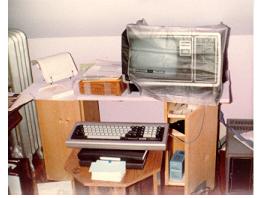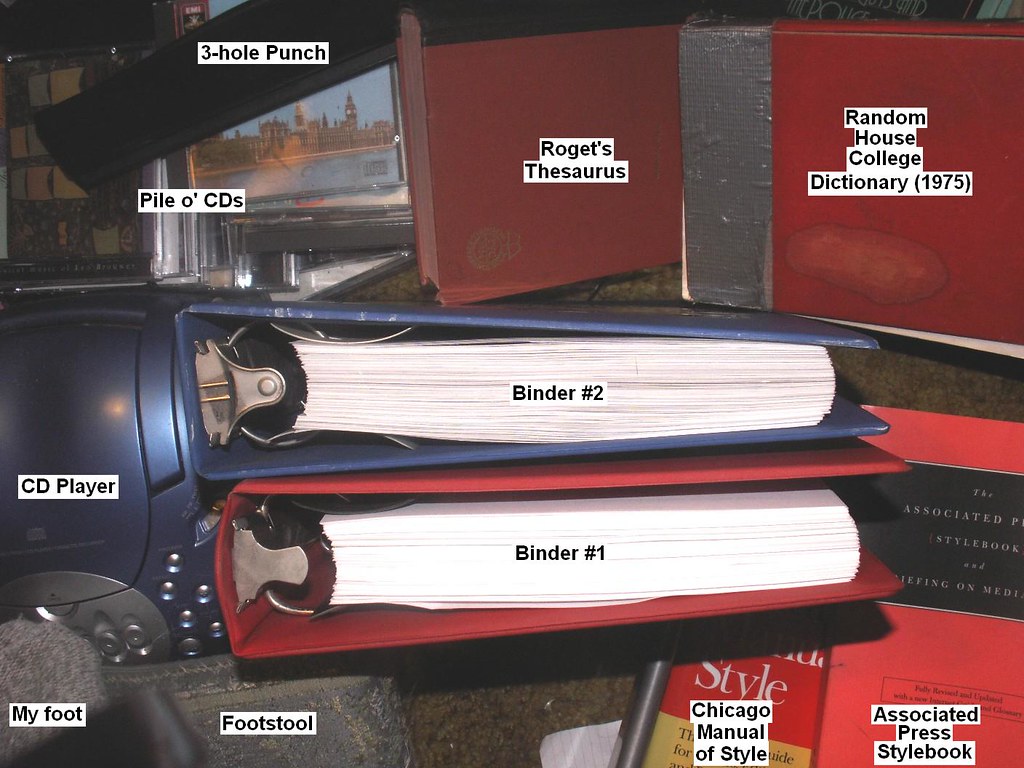Happy New Year! And Week in Review

May you all have a very happy, healthy, loving, and peaceful New Year!
Initially I photographed the watch face using a 4-second exposure (the longest one I've got) to show secondhand movement. Then I tweaked the heck out of it using MS Paint and MS Photo Editor.
This last week of 2006 has seen a device, a diagnosis, and a draft....
The Device

My "new computer" has arrived, courtesy of Asian Ideas. Now I can start to satisfy my curiosity about this thing and learn how it works, starting with Totton Heffelfinger's & Gary Flom's The Bead Unbaffled: An Abacus Manual. Events described in this entry had inspired the purchase.
For comparison, here is my "ancient computer":

This photo dates from 1983. When I moved from New York to Massachusetts I didn't have a desk, but I had bought a used woodworking book for five dollars and decided to make my own. What I spent on tools and wood probably added up to more than what I probably would have spent on a ready-made desk, but putting it together was a great experience. I also learned about the marvelous healing properties of A&D Ointment (usually found nowadays in the supermarket's baby products aisle) after a wee slip o' the backsaw.
The computer on the desk dates from 1981 and was a Radio Shack TRS-80 Model II. (I believe one of those is in the Smithsonian.) It had a word-processing program called Scripsit, which I had to boot up from an eight-inch floppy disk. I stored my writing on another eight-inch disk, which could hold a total of 256K.
That's kilobytes, not megabytes. The equivalent of 200 pages of plain, typed, double-spaced text. I sold stories typed on that machine. I held onto that computer until Mary and I moved to Florida in 2003, reluctant to part with it for purely sentimental reasons until space considerations in the rental van dictated otherwise.
The Diagnosis
On Wednesday morning I told Mary, "I always knew you were an MVP. I just didn't know you were this kind, too."
The good news is, she finally knows what's been causing a whole crapload of symptoms that have stymied those doctors who haven't dismissed them altogether as hypochondriasis. Thanks to some old hospital records that took her a long time to get (and that I mistakenly thought were unavailable altogether because it's been so long), she's discovered she has mitral valve prolapse. It's right there on her papers from 1982, when she'd been hospitalized for encephalitis and had been in a coma for almost a month.
Says Ronald Hoffman, M.D., writing for Conscious Choice, "It's a relatively benign condition, though it is linked to a confusing array of seemingly unrelated symptoms, from shortness of breath to panic attacks. Mitral valve prolapse is generally the most benign of the various types of heart murmurs, and is probably genetic in origin." Conscious Choice places the proportion of the US population affected at 5 percent.
"People with mitral valve prolapse seem somehow to be wired differently," Hoffman continues. "Their autonomic response can be much more volatile and unstable, as if set on hair-trigger, so that normal stresses and surprises set off an exaggerated response, flooding their systems with stress hormones called the catecholamines. In fact, there may not be a specific stressor—autonomic fluxes may occur unpredictably like internal weather changes....People with mitral valve prolapse are intermittently and unpredictably awash in their own catecholamines. This leaves them alternately innervated and exhausted—'wired but tired' is a common feeling."
Mary's experienced many of the symptoms and indicators that Hoffman lists in his article, and additional ones listed by Sandy Simmons of Pine Canyon Media and Dr. K.A. Scordo. These include but are not limited to vertigo, sleep disturbances, irregular heart beat, hypersensitive startle reflex, cold hands and feet, nearsightedness, scoliosis, gastrointestinal disturbances, unusual joint flexibility, and low body weight.
Mary also matches the body type most associated with this condition: female and slender, with long fingers. Her legs are relatively short, but her arms and torso are long: "arm span greater than height," according to Scordo. Simmons and Scordo both place MVP as occurring in approximately 4-18 percent of the population.
Exercise and dietary changes help to manage the condition. Surgery is recommended in cases of a severe mitral leak, and is successful in 95 percent of cases according to the Cleveland Clinic, which "has the nation's larget experience with surgery for mitral valve disease, including minimally invasive mitral valve surgery." So, a trip to Cleveland might be in our future.
But at least now Mary knows what she's up against, and I understand better the reasons for some of her behaviors that I've found upsetting in various ways over the years.
The Draft

Also on Wednesday -- oh, at about 3 AM -- I finally finished tweaking Book #4 to the point where I'm ready to inflict it on my critique group. It's still the biggest volume yet, at a shade over 151,000 words (more than half the size of the trilogy) and requiring two binders to hold it, but right now all the pieces look necessary to me. I might be able to break it into two volumes, but I'm not entirely sure about that, either. I'll see how the group takes to it. We meet twice a month and distribute fairly small pieces, so I expect the review will take at least a year.
This particular installment was a structural nightmare: an ensemble piece representing the transition from one generation and one way of life to the next. To get past writer's block I wrote my scenes in a non-linear fashion and then put my separate puzzle pieces together, a type of fiction writing I'd never done before and for whom I have Lary (one 'r') Crews to thank, in particular his line, "Tell yourself writer's block doesn't exist." More on that is in this entry.
Before I'd printed this out I had only scenes and fragments of scenes scattered all over the studio, bunched together or left separate, printed from independent files before I folded them all into the main document.
Surrounding the binders are some of my tools: style guides, dictionary, thesaurus, and the music into which I headphone myself when I write. Sometimes I set my CD player on auto-repeat for hours on end if a piece of music is a propos to the mood of a scene. Often I can point to the musical "theme" of a story or a character, because it serves as a cinematic backdrop to the movie playing in my head. Book #4 relied heavily on Rachmaninoff's Piano Concertos 2 and 4.
Over the past couple of months, following my workshopping of the trilogy, which had followed on the heels of a single novel draft, I at least showed my critique buddies that:
(a) Yes, I can give them short fiction; and
(b) Yes, I can give them nonfiction
-- both types of which are currently out to market. Before then, all they'd seen from me was novel-length work. Now that I've got that business taken care of, I'll sic #4 on 'em.
Clouds were whizzing across the face of the Moon late Friday night when I took this 4-second exposure at f/8.

I've finally gotten the hang of the timed-release function, so I can step back after I push the shutter button and not worry about inadvertently jostling my camera. Windy conditions are another matter, but Friday night was pretty calm.
Blessings to all of you and yours for 2007. Hang onto your dreams, keep on keepin' on, and carpe diem!











5 Comments:
Thank you for posting the information about Mary's mitral valve prolapse. Believe it or not, my wife suffers many of those same symptoms, and she has been diagnosed with a heart murmur. We have had the worst experiences with doctors who assume that she is merely suffering from anxiety. Your info about mvp gives us something to explore. I like the picture of your draft, too!
Scott
With a solid prognosis finally you can begin to not just understand but perhaps heal Mary's MVP. Many blessings to her...
And Happy New Year you two! Many good wishes for much good fortune for you...
hugs, love Brenda xo
Interesting information about MVP and I am glad that Mary has a proper diagnosis....sound like your year is off to a giids start!
I'v wondered at time whether my CFS symptoms are really MVP. I have the wiring you mention that runs from feeling nervously pumped up to exhaustion often at the same time, shortness of breath and other symptoms. I have had two night time heart incidents where it felt like I was having a heart attack. Has that ever happened to Mary? I tried to check this possiblity out a few years back but finding a doctor who's on the ball is a whole other matter. Most don't seem to know anything about it. Do you think I should look for a heart specialist? I'm also afraid to open myself to all the poking and prodding that might come of it.
This is a great post on the reality of Mitral Valve Prolapse in every day life. I had Mitral Valve Prolapse and had it treated at Heathworx in Miami. Luckily they offered onsite counseling to help assure me I wasn't going nuts from the symptoms. Great post and keep it up.
Post a Comment
<< Home